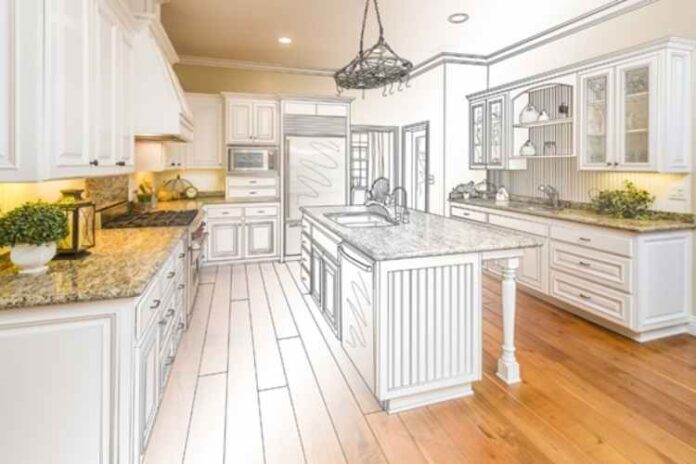According to Remodeling Magazine’s latest Cost-vs-Value report, even a minor kitchen remodel can yield a 72.2% ROI when you sell your home.
A new kitchen brings more benefits than financial returns, though. When you re-imagine your kitchen, you’re creating a space for unhindered cooking and a welcoming meeting place for friends and family.
Are you ready to get started? Check out this concise kitchen layout planner to help you in your quest for the perfect design.
Become a Master Kitchen Layout Planner
Designing the ultimate kitchen depends on a few key aspects. All the best kitchen layouts must include:
Logical Design
Only you know what works for you in your kitchen. Keep your main tasks in mind and make sure key elements are close to each other.
A triangular path between key elements like the stove, sink, and fridge usually works best.
It’s never a good idea to put key aspects like the cooking area, fridge, and sink across the room or around the corner from each other. Consider placing a hot water tap close to your stove, so you don’t have to carry heavy pots across the room when you want to add water.
If you use certain appliances often, like your microwave, make sure they’re accessible and at a comfortable height.
Traffic Flow
Do you have an exterior doorway in your kitchen? People are bound to use it as an entryway during your busiest time in the kitchen.
Design your kitchen so that the stove is nowhere near the doorway. This prevents inadvertent burns if boisterous children come bustling through the door, or an unsteady toddler leans on it to negotiate the door handle.
Keep a wide, clear thoroughfare between the door and living areas of your home.
Planning for Appliances
If you’re gutting your kitchen, remember to accommodate appliances near power sources. Extension cords are a safety hazard in the kitchen and don’t mix well with water.
You must always place stoves on an exterior wall. This makes it easier to install a ventilation system.
Convenient Countertops
Never underestimate how many countertops you need. Make sure you provide plenty of space for utensils and countertop appliances in your design.
Color plays a major role in countertops, too. Quartz and granite countertops show dirt less easily than countertops with a flat color design.
You should also keep maintenance and durability in mind when installing countertops. A kitchen is a messy place, so it’s vital to choose a heat-resistant material, that won’t warp, and wipes clean easily.
Storage Space
There’s no end to the storage space you’ll need in your kitchen. Out of sight is out of mind when it comes to gadgets, cutlery, and other small items.
Insufficient storage causes clutter, attracts dust, and spoils all your kitchen design efforts. There are many innovative storage concepts available nowadays, like Lazy Susans, cabinet drawers, and box drawers that help you keep things tidy.
Making use of vertical storage can save a lot of floor space in your kitchen.
Classic Kitchen Layouts
According to https://kitchenremodelingmiamidade.com/, there are four major zones in any kitchen. These are the refrigerator and food, cooking and serving, sink and cleaning, and dining areas.
When you go with one of the established types of kitchen layout, you know it’s laid out to make the most of the kitchen’s key aspects. If necessary, you can easily adjust these floor plans to suit the unique aspects of your kitchen.
Some common kitchen layout ideas include:
One-Wall Kitchen
This design is common in small kitchen layouts and studio apartments. This design encompasses a single wall featuring all the main aspects of your kitchen i.e. the refrigerator, stove, and sink.
Often, you’ll need specialized, smaller appliances to fit into this design, and you’ll have limited counter space.
Galley Kitchen
Galley kitchens are like one-wall kitchens, except they use two opposite walls to maximize space. It’s easy to reach various appliances if you choose this layout since the small area makes it easy to reach everything.
Vertical storage is a boon in both galley kitchens and one-wall kitchens.
L-Shaped Kitchen
This popular, practical layout involves placing workspaces on two adjoining walls running perpendicular to one another. It’s a spacious design that offers better flexibility when it comes to meal prep and placing appliances.
U-Shaped Kitchen
A U-shaped kitchen adds an extra perpendicular wall to the L-shaped layout. The walls almost surround the cook, allowing plenty of space for meal prep and moving about the space.
Avoid placing upper cabinets on all three walls as this creates a claustrophobic feel. A U-shaped kitchen works well if you want to separate your cooking area from your dining area.
Island Kitchen Layout
The kitchen island is a modern-day must-have for larger kitchens. This extra central counter space provides extra square footage for meal prep, appliance placement, or dining.
Some kitchen islands feature sinks, stovetops, under-counter fridges, and extra storage like drawers, shelves, or cabinets.
A kitchen island promotes natural traffic flow in the kitchen and serves as both an area for work and socializing.
Peninsula Kitchen
Like the Island-style kitchen, a peninsula kitchen has a central counter, except it’s connected to one of the walls. Essentially, a peninsula kitchen creates a U-shape from an L-shaped kitchen.
They work very well for creating extra counter space in kitchens that are too small for a kitchen island.
Add Value to Your Daily Routine
A good kitchen is a joy to behold and something you’ll appreciate every day, so take these kitchen layout planner tips to heart and spend some time working out a plan that suits your ideals.
With a little forethought, you can turn any kitchen into the perfect space for you.
Are you always keen to discover new ways to improve your home and your life? Browse our blog for more home improvement inspiration and lifestyle tips.


